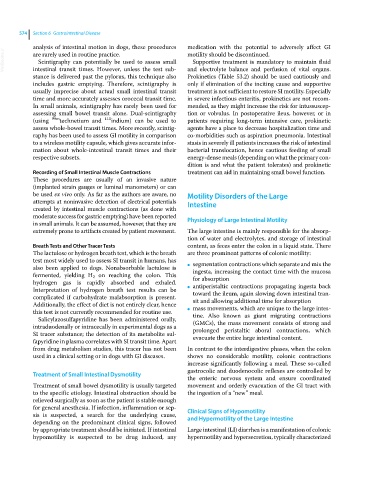Page 606 - Clinical Small Animal Internal Medicine
P. 606
574 Section 6 Gastrointestinal Disease
analysis of intestinal motion in dogs, these procedures medication with the potential to adversely affect GI
VetBooks.ir are rarely used in routine practice. motility should be discontinued.
Scintigraphy can potentially be used to assess small
Supportive treatment is mandatory to maintain fluid
intestinal transit times. However, unless the test sub-
Prokinetics (Table 53.2) should be used cautiously and
stance is delivered past the pylorus, this technique also and electrolyte balance and perfusion of vital organs.
includes gastric emptying. Therefore, scintigraphy is only if elimination of the inciting cause and supportive
usually imprecise about actual small intestinal transit treatment is not sufficient to restore SI motility. Especially
time and more accurately assesses orocecal transit time. in severe infectious enteritis, prokinetics are not recom-
In small animals, scintigraphy has rarely been used for mended, as they might increase the risk for intussuscep-
assessing small bowel transit alone. Dual‐scintigraphy tion or volvulus. In postoperative ileus, however, or in
(using 99m technetium and 111 indium) can be used to patients requiring long‐term intensive care, prokinetic
assess whole‐bowel transit times. More recently, scintig- agents have a place to decrease hospitalization time and
raphy has been used to assess GI motility in comparison co‐morbidities such as aspiration pneumonia. Intestinal
to a wireless motility capsule, which gives accurate infor- stasis in severely ill patients increases the risk of intestinal
mation about whole‐intestinal transit times and their bacterial translocation, hence cautious feeding of small
respective subsets. energy‐dense meals (depending on what the primary con-
dition is and what the patient tolerates) and prokinetic
Recording of Small Intestinal Muscle Contractions treatment can aid in maintaining small bowel function.
These procedures are usually of an invasive nature
(implanted strain gauges or luminal manometers) or can
be used ex vivo only. As far as the authors are aware, no Motility Disorders of the Large
attempts at noninvasive detection of electrical potentials Intestine
created by intestinal muscle contractions (as done with
moderate success for gastric emptying) have been reported Physiology of Large Intestinal Motility
in small animals. It can be assumed, however, that they are
extremely prone to artifacts created by patient movement. The large intestine is mainly responsible for the absorp-
tion of water and electrolytes, and storage of intestinal
Breath Tests and Other Tracer Tests content, as feces enter the colon in a liquid state. There
The lactulose or hydrogen breath test, which is the breath are three prominent patterns of colonic motility:
test most widely used to assess SI transit in humans, has segmentation contractions which separate and mix the
also been applied to dogs. Nonabsorbable lactulose is ● ingesta, increasing the contact time with the mucosa
fermented, yielding H 2 on reaching the colon. This for absorption
hydrogen gas is rapidly absorbed and exhaled. antiperistaltic contractions propagating ingesta back
Interpretation of hydrogen breath test results can be ● toward the ileum, again slowing down intestinal tran-
complicated if carbohydrate malabsorption is present. sit and allowing additional time for absorption
Additionally, the effect of diet is not entirely clear, hence mass movements, which are unique to the large intes-
this test is not currently recommended for routine use. ● tine. Also known as giant migrating contractions
Salicylazosulfapyridine has been administered orally,
intraduodenally or intracecally in experimental dogs as a (GMCs), the mass movement consists of strong and
prolonged peristaltic aboral contractions, which
SI tracer substance; the detection of its metabolite sul- evacuate the entire large intestinal content.
fapyridine in plasma correlates with SI transit time. Apart
from drug metabolism studies, this tracer has not been In contrast to the interdigestive phases, when the colon
used in a clinical setting or in dogs with GI diseases. shows no considerable motility, colonic contractions
increase significantly following a meal. These so‐called
gastrocolic and duodenocolic reflexes are controlled by
Treatment of Small Intestinal Dysmotility
the enteric nervous system and ensure coordinated
Treatment of small bowel dysmotility is usually targeted movement and orderly evacuation of the GI tract with
to the specific etiology. Intestinal obstruction should be the ingestion of a “new” meal.
relieved surgically as soon as the patient is stable enough
for general anesthesia. If infection, inflammation or sep- Clinical Signs of Hypomotility
sis is suspected, a search for the underlying cause, and Hypermotility of the Large Intestine
depending on the predominant clinical signs, followed
by appropriate treatment should be initiated. If intestinal Large intestinal (LI) diarrhea is a manifestation of colonic
hypomotility is suspected to be drug induced, any hypermotility and hypersecretion, typically characterized

